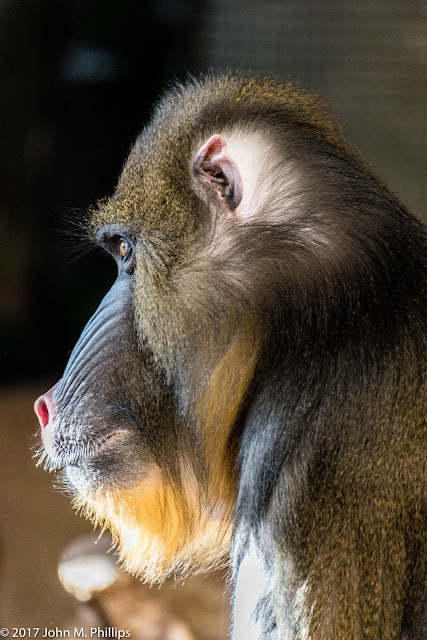Early on I visited the primate house and took a few photos of the spider monkeys.
This second shot reminded me of a Notre Dame gargoyle in its pose.
I also visited the aviary, despite the fact that the sign at the entrance declared that it was closed. First up, the rhinoceros hornbill.
I could only speculate on what sort of evolutionary factors led to this bird's second, fake bill. The mottled appearance of this shot is the result of a screen that I had to shoot through.
Another interesting bird was the Victoria crowned pigeon. This bird seemed content to pose for me. I probably took 15-20 shots, retaining these.
I know I am supposed to focus on the animal's eye, but here I was most intent on bringing the crest plumage into focus. I'm not sure it made any difference. For the record, these were shot at f/5.6 at an ISO of 4000 and a shutter speed of either 1/160 or 1/125 second. Sometimes high ISOs can create a great deal of "noise," but these shots looked pretty good.
I took this shot of a Guam kingfisher because the docent stationed near it told me the bird was near extinction with no remaining specimens in the wild.
Finally, for birds I liked the following tropical bird that I thought would have been comfortable in a cartoon. Perhaps it was the combination of outrageous beak and fake-looking eye.
The only animal I am featuring from the reptile house was an iguana. The lighting in the reptile house was especially dim. However, reptiles tend to be relatively good photo subjects because they are slow movers. This one seemed content to rest, just occasionally moving its head up and down.
My goal here was to capture the texture of the iguana's scales and, well, warts. That proved harder than I thought because I had to shoot at a fairly wide open aperture, reducing the depth of field. One more thing. Because the animals in the reptile house are fairly close (though behind glass), I switched from a telephoto lens (70 to 300 mm) to one with a more standard focal range (24 to 120 mm). The telephoto required that I be at least five feet from the subject, while the more normal zoom let me focus from as close as a foot or so.
Then it was on the the big mammals. So I switched back to my telephoto and was able to use lower ISOs and somewhat smaller apertures.
First a caribou with an impressive rack.
And a polar bear more intent on pacing than posing.
I did take a few shots of one of the elephants, this one I converted to a black and white.
Just so-so, I thought. I had better luck with the hippo, an incredibly ugly animal, imho.
I took these at an aperture of f/5.6, which seemed adequate to provide broad depth of field, considering the distance to the subject. The texture of the animal's skin came through with great clarity. The ISO for these shots was a low 100 and the shutter speed was 1/320 second. Adequacy of light can make such a difference.
The giraffe was a long way off, so I included the whole animal and got a surprise visit from a juvenile poking its head out for a visit with the adult.
Here are some shots of the big cats. The light was lower, but the technical quality seemed decent.
Technically, the leopard shot was the best, but I thought the lion shot, despite his being positioned away from me, was more dramatic because of the lighting and the lion's regal pose. The definition on the lion's mane, being backlit by the sun, came out great.
Easily my favorite photos from this visit were of the mandrills in the primate house. First, a female (males and females, I learned, are differentiable by the differing coloration of their snouts.)
Nice beard for a female.
Then the male,
who was looking right at me, as evidenced by this cropped closeup.
I need more practice photographing animals. I am used to photographing inanimate objects--architecture, landscapes, etc.--because they generally don't move. Animals typically keep moving and I have trouble "pulling the trigger," worried that I am not getting the ideal shot. So I often miss the shot. There are other issues with photographing animals, including in a zoo setting. First, they generally don't pose for the camera. They may be facing away from me or may be constantly on the move. Second, particularly in colder weather, they are often indoors, where there is much less light or the color of the light may be an issue. I can generally compensate for white balance (color) issues, but quantity of light requires some compromises. I must either open up the aperture, reducing depth of field, or ramp up the ISO or hope for the best with a slower shutter speed, or some combination of the above. Finally, the animals are often behind barriers--glass or screens. Glass can include reflections and smudges, and screens create opacities and can confuse my camera's autofocus system. OK, so much for the excuses. In the two hours of my visit, I took over 200 shots, retaining about 30, or 15 percent, about par for the course.
John






















Great pictures of happy animals. You really have an extremely great talent of taking pictures, paying attention to detail.
ReplyDelete